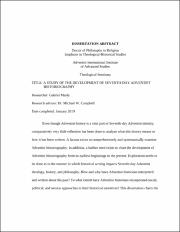A Study of the development of Seventh-day Adventist historiography
Abstract
Even though Adventist history is a vital part of Seventh-day Adventist identity, comparatively very little reflection has been done to analyze what this history means or how it has been written. A lacuna exists to comprehensively and systematically examine Adventist historiography. In addition, a further need exists to chart the development of Adventist historiography from its earliest beginnings to the present. Exploration needs to be done as to the manner in which historical writing impacts Seventh-day Adventist theology, history, and philosophy. How and why have Adventist historians interpreted and written about the past? To what extent have Adventist historians incorporated social, political, and secular approaches to their historical narratives? This dissertation charts the
growth and development of Adventist historical consciousness and thus reflects on how Adventist historians describe the past.
This dissertation describes three major trends within the development of Seventh-day Adventist historiography. First, the writing of history began as an extension of an interest in Bible prophecy and a conviction about God’s providential leading in the rise of Adventism (theological-fideist history). Second, Adventist history remained important in order to do successful apologetics, affirm the faith of church members, and provide new resources such as textbooks and affirmations of the prophetic gift through the life and writings of Ellen G. White. Third, more critical methods were gradually incorporated that challenged traditional narratives of Adventist history. These methods incorporated new and more objective ways that considered natural causation in history. Historians following this school began to look for more credible evidence to support earlier claims about Adventist history. These new critical approaches generated a wide range of responses, all of which continue to be promulgated within Adventism up to the present day.
Adventist historiography is complex. A recognition of this complexity makes it obvious that it is impossible to have a single narrative within Adventist historiography, nor should there be merely one. A wide range of methods exists that allows for an even wider variety of historical narratives about the Adventist past. Most of these approaches serve some valuable purpose so long as there is a consistent methodology and honesty about sources. In addition, a wide variety of personalities have each brought unique perspectives and idiosyncrasies about how such narratives are told. Each approach here
analyzed has contributed to the development of an acceptable methodology for interpreting history from a Seventh-day Adventist perspective.


